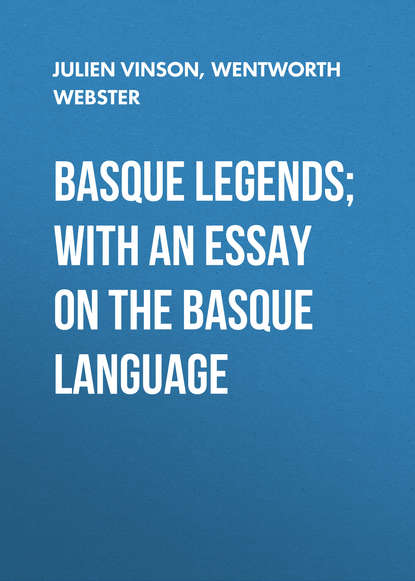По всем вопросам обращайтесь на: info@litportal.ru
(©) 2003-2024.
✖
Basque Legends; With an Essay on the Basque Language
Автор
Год написания книги
2018
Настройки чтения
Размер шрифта
Высота строк
Поля
92
Cf. MacCraw’s variation in Campbell, note, Vol. II., p. 301, for the rest of the story.
93
“Power” in these tales, in the Basque, seems always to mean “magic power,” some wonder-working gift or charm.
94
In Campbell’s versions it is “the realm of the king under the waves,” or “the realm of the rats;” but a voyage has to be made to that, and a rat takes the place of the servant in stealing the box again for the hero. “The Deccan Tales” mention the Red Sea.
95
The south wind is the most dreaded local wind in the Pays Basque. It is always hot, and sometimes very violent. After two or three days it usually brings on a violent thunderstorm and rain.
96
The lad here calls his snuff-box affectionately “Que quieres,” as if that were its name.
97
The likeness and the variation of this tale from Campbell’s Gaelic one, “The Widow’s Son,” etc., Vol. II., pp. 293–303, prove that both must be independent versions of some original like Aladdin’s lamp, but not mere copies of it.
98
This doubling of a price is to get a thing more quickly done—in half the usual time. At least, that was the narrator’s explanation.
99
These three clever men are found in Gascon (Bladé’s “Armagnac Tales,” p. 10), in Spanish, in Campbell’s “The King of Lochlin’s Three Daughters,” Vol. I., p. 238, and in many others. Cf. Brueyre, pp. 113–120, and notes.
100
Cf. The tale from the Servian, in Naaké’s “Slavonic Fairy Tales,” p. 7.
101
i.e., the piece of “braise,” or glowing ember from the wood fire, which is always nearly on a level with the floor in a Basque house.
102
Through the whole of the South of Europe, in Greece, Italy, Spain, Portugal, etc., the firing of guns, pistols, crackers, is universal at all kinds of “fêtes,” especially religious ones; the half-deafened foreigner often longs for some such law as that infringed by “Mahistruba;” but cf. “Juan de Kalais,” p. 151.
103
Cf. supra, p. 38, “The Serpent in the Wood.”
104
This tale is somewhat like Campbell’s “Three Soldiers,” with the variations, Vol. I., p. 176. It is said to be very widely spread.
105
This is an interpolation by the narrator.
106
At Bayonne one part of the town is called “Les Cinq Cantons.”
107
For like involuntary sleep, where the lady cannot awaken her lover, cf. Campbell, “The Widow’s Son,” Vol. II., p. 296.
108
For the incident of the eagle, cf. Campbell, “The King of Lochlin’s Three Daughters,” Vol. I., pp. 238–9:—“When they were at the mouth of the hole, the stots were expended, and she was going to turn back; but he took a steak out of his own thigh, and he gave this to the eagle, and with one spring she was on the surface of the earth.”
109
Cf. the horse in Naaké’s “Slavonic Fairy Tales,” “Ivan Kruchina” (from the Russian), p. 117, and “the dun shaggy filly,” in Campbell’s “The Young King of Easaidh Ruadh,” Vol. I., p. 5, and elsewhere; also the horse in the “Uso-Andre,” and “The Unknown Animal,” below. Campbell, Vol. I., p. 63, remarks that the horses in Gaelic stories are always feminine; but they are red as well as grey.
110
In this, and the following tale, Ezkabi’s golden hair is evidently like “Diarmaid’s” beauty spot. “He used to keep his cap always down on the beauty-spot; for any woman that might chance to see it, she would be in love with him.”—Campbell’s “Diarmaid and Grainne,” Vol. III., p. 39, notes and variations.
111
Compare the following legend, and “Old Deccan Days” (“Truth’s Triumph”), pp. 62, 63.
112
Cf. above, “The Grateful Tartaro and the Heren-Suge,” p. 22.
113
Cf. note, supra, p. 113, and Grainne seeing Diarmaid as he lifts his cap or helmet. These beauty-spots seem to be the counterpart of Aphrodite’s cestus.
114
Cf. the two golden pears in the Spanish “Juanillo el Loco,” Patrañas, p. 38, given in exchange for the same water.
115
Cf. below, “The Singing Tree,” etc., p. 176.
116
Cf. “Old Deccan Days,” p. 139; and Cox, “Aryan Mythology,” Vol. I., p. 160, seq.
Cf. MacCraw’s variation in Campbell, note, Vol. II., p. 301, for the rest of the story.
93
“Power” in these tales, in the Basque, seems always to mean “magic power,” some wonder-working gift or charm.
94
In Campbell’s versions it is “the realm of the king under the waves,” or “the realm of the rats;” but a voyage has to be made to that, and a rat takes the place of the servant in stealing the box again for the hero. “The Deccan Tales” mention the Red Sea.
95
The south wind is the most dreaded local wind in the Pays Basque. It is always hot, and sometimes very violent. After two or three days it usually brings on a violent thunderstorm and rain.
96
The lad here calls his snuff-box affectionately “Que quieres,” as if that were its name.
97
The likeness and the variation of this tale from Campbell’s Gaelic one, “The Widow’s Son,” etc., Vol. II., pp. 293–303, prove that both must be independent versions of some original like Aladdin’s lamp, but not mere copies of it.
98
This doubling of a price is to get a thing more quickly done—in half the usual time. At least, that was the narrator’s explanation.
99
These three clever men are found in Gascon (Bladé’s “Armagnac Tales,” p. 10), in Spanish, in Campbell’s “The King of Lochlin’s Three Daughters,” Vol. I., p. 238, and in many others. Cf. Brueyre, pp. 113–120, and notes.
100
Cf. The tale from the Servian, in Naaké’s “Slavonic Fairy Tales,” p. 7.
101
i.e., the piece of “braise,” or glowing ember from the wood fire, which is always nearly on a level with the floor in a Basque house.
102
Through the whole of the South of Europe, in Greece, Italy, Spain, Portugal, etc., the firing of guns, pistols, crackers, is universal at all kinds of “fêtes,” especially religious ones; the half-deafened foreigner often longs for some such law as that infringed by “Mahistruba;” but cf. “Juan de Kalais,” p. 151.
103
Cf. supra, p. 38, “The Serpent in the Wood.”
104
This tale is somewhat like Campbell’s “Three Soldiers,” with the variations, Vol. I., p. 176. It is said to be very widely spread.
105
This is an interpolation by the narrator.
106
At Bayonne one part of the town is called “Les Cinq Cantons.”
107
For like involuntary sleep, where the lady cannot awaken her lover, cf. Campbell, “The Widow’s Son,” Vol. II., p. 296.
108
For the incident of the eagle, cf. Campbell, “The King of Lochlin’s Three Daughters,” Vol. I., pp. 238–9:—“When they were at the mouth of the hole, the stots were expended, and she was going to turn back; but he took a steak out of his own thigh, and he gave this to the eagle, and with one spring she was on the surface of the earth.”
109
Cf. the horse in Naaké’s “Slavonic Fairy Tales,” “Ivan Kruchina” (from the Russian), p. 117, and “the dun shaggy filly,” in Campbell’s “The Young King of Easaidh Ruadh,” Vol. I., p. 5, and elsewhere; also the horse in the “Uso-Andre,” and “The Unknown Animal,” below. Campbell, Vol. I., p. 63, remarks that the horses in Gaelic stories are always feminine; but they are red as well as grey.
110
In this, and the following tale, Ezkabi’s golden hair is evidently like “Diarmaid’s” beauty spot. “He used to keep his cap always down on the beauty-spot; for any woman that might chance to see it, she would be in love with him.”—Campbell’s “Diarmaid and Grainne,” Vol. III., p. 39, notes and variations.
111
Compare the following legend, and “Old Deccan Days” (“Truth’s Triumph”), pp. 62, 63.
112
Cf. above, “The Grateful Tartaro and the Heren-Suge,” p. 22.
113
Cf. note, supra, p. 113, and Grainne seeing Diarmaid as he lifts his cap or helmet. These beauty-spots seem to be the counterpart of Aphrodite’s cestus.
114
Cf. the two golden pears in the Spanish “Juanillo el Loco,” Patrañas, p. 38, given in exchange for the same water.
115
Cf. below, “The Singing Tree,” etc., p. 176.
116
Cf. “Old Deccan Days,” p. 139; and Cox, “Aryan Mythology,” Vol. I., p. 160, seq.
Другие электронные книги автора Wentworth Webster
Spain




 0
0






